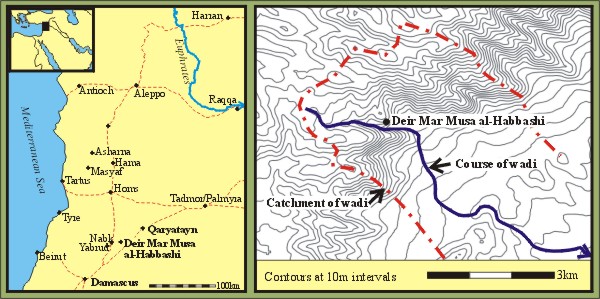![]() Robert B. J. Mason
Robert B. J. Mason
Near and Middle-Eastern Civilizations (NMC)
University of Toronto
|
Near and Middle-Eastern Civilizations (NMC) |
|
University of Toronto - Near and Middle Eastern Civilizations - Mason Home - Unnofficial Mason - Royal Ontario Museum |
|
Archaeology at Deir Mar Musa al-Habashi Archaeological survey and excavations in the area of the monastery
The archaeological project at Deir Mar Musa al-Habashi, involves survey of the catchment of the wadi (see map, below);
together with excavation at selected sites.
The region is presently extremely arid, and comprises a ridge of limestone, scattered with caves.

Map showing location of Deir Mar Musa al-Habashi (contour map courtesy of Steven Batiuk)
Preliminary reconnaissance and discussions with the monastic community has indicated that there is some evidence of Prehistoric use of the landscape, with occasional finds of stone tools, probably of the Epipalaeolithic era. Although it is thought that the monastic buildings are founded on the core of a Roman watchtower, no archaeological evidence for this presently exists except for the well-dressed large stones of the masonry of certain parts of the building, and there is no evidence of any occupation of the region between the Epipalaeolithic (circa 10-12 thousand years BC) and Roman periods. The monastic buildings themselves provide evidence of occupation in subsequent periods. The church itself is typical of the basilical form of the 5th to 6th century, as are motifs carved into the stonework of the church. The frescoes attest to occupation in the 11th and 12th centuries. However, the 2004 study season of finds from the earlier restorations indicate that it is not until the 14th century AD that there are significant finds of ceramics to give a more thorough understanding of the continuity of occupation of the site, and even this is due to the abandonment of certain rooms and so represents the beginning of the decline of the monastery, which would eventually be abandoned by 1831 CE. The archaeological study will provide a fuller picture of occupation of the Wadi Deir Mar Musa al-Habashi. Survey of the valley, begun in the 2005 season, is aimed at identifying any archaeological evidence. Although any find or feature will be recorded, it is expected that the findings will reflect, and hopefully expand upon, the previously established history of use of the region. This will primarily involve field-walking accompanied by use of a hand-held Global Position System to identify and locate all archaeological remains, and of each cave that may have been occupied in the past. Prospection for possible excavation sites will also be undertaken, and limited excavation. In 2007 more extensive excavations will occur at a number of selected sites. Some excavation sites have yet to be identified, but some are already determined. The known proposed sites comprise a midden, or rubbish-dump, in the valley below the monastery buildings, which probably represents the only continuous record of occupation of the site, the monastery mortuary area, and two caves occupied in the medieval period. Each of these sites represent an area of perhaps 10-20 sq metres and a stratigraphic depth of perhaps 50 cm, and so would not be a formidable excavation challenge. The sites yet to be located, which will likely be other caves occupied in the medieval period, will most likely be of a similar proportion.
Deir Mar Musa al-Habashi
|
|
|
University of Toronto - Near and Middle Eastern Civilizations - Mason Home - Unnofficial Mason - Royal Ontario Museum |